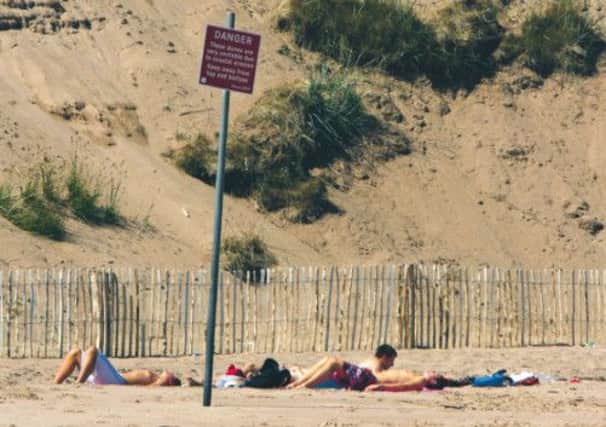Scotland’s beaches appear to be ‘shrinking’


A new study has found that the low tide mark is moving closer to land at a much quicker rate than the high tide mark, effectively causing the beach in between to reduce in size as sediment is lost.
Detailed surveys at a test site in the Clyde estuary revealed that sections of the shoreline have been eroded at an average rate of more than a metre per year since 1940.
Advertisement
Hide AdAdvertisement
Hide AdExperts at the University of Glasgow warned that the findings – at Kames Bay on Bute – reflect a national picture, with hundreds of miles of shoreline under growing threat of progressive decline.
While the main cause of erosion was identified as climate change, with rising sea levels and increasingly extreme storms, it was also blamed on a man-made solution to the threats, with sea walls increasing the rate at which sand was being lost.
The research team suggested a ban on future coastal developments in some areas to avoid the need for artificially protecting homes and businesses and the adoption of more natural methods of combating erosion.
As well as the trial, the study also involved a study of the position of both low and high water marks on Scottish beaches over the last century.
Glasgow University geomorphologist Dr Jim Hansom, the co-author of the study and adviser to government agencies on coastal erosion, said: “Detailed surveys have identified that the lowest astronomic tide (low water mark) is moving landwards at the test site at a much faster rate than the high water mark.
“That means that you are losing sediment from the intertidal zone. This means that beaches are steepening and lowering due to loss of sediment and eventually we will run out of beaches.
“We have long recognised that beaches are wasting assets but it seems that the pace of loss is increasing. The rate of change varies depending on local factors so it is not possible to cite a specific rate for Scotland as a whole, but the pattern is very clear. Beaches are disappearing.”
Hansom said the traditional response to rising sea levels and increasing storms had been to build sea walls and other defences: “But as soon as you begin to harden the coastline using sea walls you have got an issue as barriers prevent particles being deposited, which removes even more
sediment, so we are also part of the problem.
Advertisement
Hide AdAdvertisement
Hide Ad“Engineering is clearly part of the solution in places where infrastructure exists – for example at Leith or Grangemouth – but in many areas it would be much better to free up the coast. There should be no development on eroding coasts, and arguably no development on any coastline unless it is absolutely essential, because as soon as you get real estate on the coast you have the potential pressure in the future to protect it from erosion.”
He cites as an example US tycoon Donald Trump’s new golf course at Menie Links on the Aberdeenshire coast, which he claims is already suffering from erosion.
“That’s what has already happened to Donald Trump’s golf course… and he is protecting it at the third green. This then reduces the sediment supply for the adjacent
beaches. It simply moves the problem elsewhere,” he said.
Hansom added that James Fitton, a postgraduate researcher with the team, had developed a mapping system for Scottish Natural Heritage (SNH) and the Scottish Environment Protection Agency to identify the areas of the Scottish coast that are most susceptible to erosion.
“Using this new information about our coast, we now need to open a dialogue about how to work with these changing processes,” he said. “Strategic planning is needed, as well as more intelligent controls over coastal development than those that exist at present. It will cost less if we act sooner rather than delaying any action into the future when the problems will be more pressing and more severe for society.”
A Scottish Government spokeswoman said it would consider the report’s findings: “Coastal erosion is a natural event and its existence, and work to address it, is set out in the draft Climate Change Adaptation Programme which is currently out for public consultation.
“Development plans should recognise that the coast is a major focus of economic activity and identify areas likely to be suitable for development, areas subject to significant constraints (including those at risk from coastal erosion and flooding) and areas unsuitable for development.”
SNH, the government’s countryside agency, said Dr Hansom’s findings were consistent with earlier investigations. “The installation of
Advertisement
Hide AdAdvertisement
Hide Adunsympathetic defences which ignore the natural processes can often lead to problems elsewhere. We advocate approaches that retain the natural coastal habitats, processes and landscapes and that enable coastlines to evolve naturally,” the spokesman said.
“We agree that development of unprotected shorelines should be, and is, discouraged where such developments could not be adequately
safeguarded over the lifetime of the development without the construction of coastal defences.”
One of the most endangered coastlines in Scotland are the shores around the Northern and Western Isles, which are sinking as sea levels rise.
Last year, Oxfam launched a project on the Western Isles to help residents take steps themselves to save the coastline. Islanders have been planting trees, keeping livestock off sand dunes to help them recover from erosion and improving drainage to protect land from flooding.